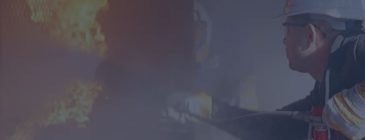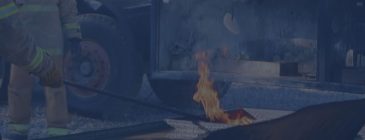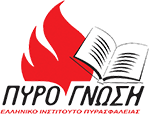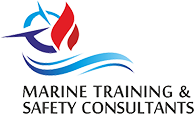AFF is compliant with the STCW ‘95 requirements (A.VI/3) and approved by the governments of Liberia, Cyprus, Malta, Bahamas and the Marshal Islands. It was initially introduced to the marine time community in 1968 and since then it has been battened by deck and engine officers as well as marine and engineer superintendents. . The AFF course is well known for its high quality and effective training.
Course
Objectives
The course addresses to deck and engine officers and seafarers designated to control fighting operations.
- Understand the objectives and importance of fire prevention and fire training in order to improve safety on board and operational – economic efficiency.
- Be aware of direct and indirect fire risks in various compartments.
- Be able to classify various types of fuels, identify the appropriate method of extinction and determine the optimum equipment to be used in each case.
- Be able to take responsibility and ensure proper inspection and service firefighting systems and equipment.
- Be aware of the importance of correct emergency organization on board, including:
– Allocation of duties
– Firefighting and extinguishing coordination
– Effective communication - Be able to influence and inspire officers and crew to participate with enthusiasm in on-board training and drills.
- Be able to use the most effective training methods and implement drills on-board.
- Be aware of the overall strategy and tactics in order to control a major shipboard fire.
- Be aware of real on-board firefighting difficulties and therefore appreciate the importance of fire prevention.
- Be able to acquire the necessary skills in order to combat on-board fires using all available means and equipment.
- Be able to organize and implement seminars and actions that increase fire prevention and protection consciousness of officers and crew and ensure the effective applications of fire prevention and protection principles.
- Be able to investigate and report fire incidents appropriately.
- Be able to report to decision makers regarding new and updated firefighting equipment, media and techniques to be purchased – installed.
Course
Theory
- The nature of the problem, reference on cases of major and minor on-board fires, illustrating officers and crew casualties, injuries and financial losses for the owners, charterers and underwriters.
- The human factor and the need for continuous training of officers and crew either on-board with specific training programs either off board.
- Chemistry of fire. Fire and fuels classification and properties.
- Causes of ship fires and prevention actions and mechanisms
- The ship’s Safety Committee, its role, functions and tools – means available for achieving its goals. Head office support.
- Ship’s fire proofing design, construction, inspection and maintenance.
- Fire detections systems, operation, inspection and maintenance.
- Extinguishing agents, their properties and suitability.
- Portable and semi portable firefighting equipment. Use, inspection and maintenance.
- Fixed firefighting systems. Operation, inspection and maintenance.
- Burning properties of material found on modern ships. Physiology of respiration. Proper use, inspection and maintenance of breathing apparatus.
- Other fire safety equipment (outfits, PPE, etc.).
- Personal training organization. Design and execution of realistic fire drills.
- Fire safety inspections using checklists.
- Firefighting operations hazards (heat, flames, toxic gases, etc.).
- Training the trainers: this unique section emphasizes on the means and methods that can be used by officers to implement on-board crew training as well as realistic and effective drills.
During the theoretical part, intensive use of audiovisual means such as:
- Equipment demonstration
- Videos and slides
- Experiments demonstrating fire hazards and firefighting principles contribute to the better understanding of the training material and content.
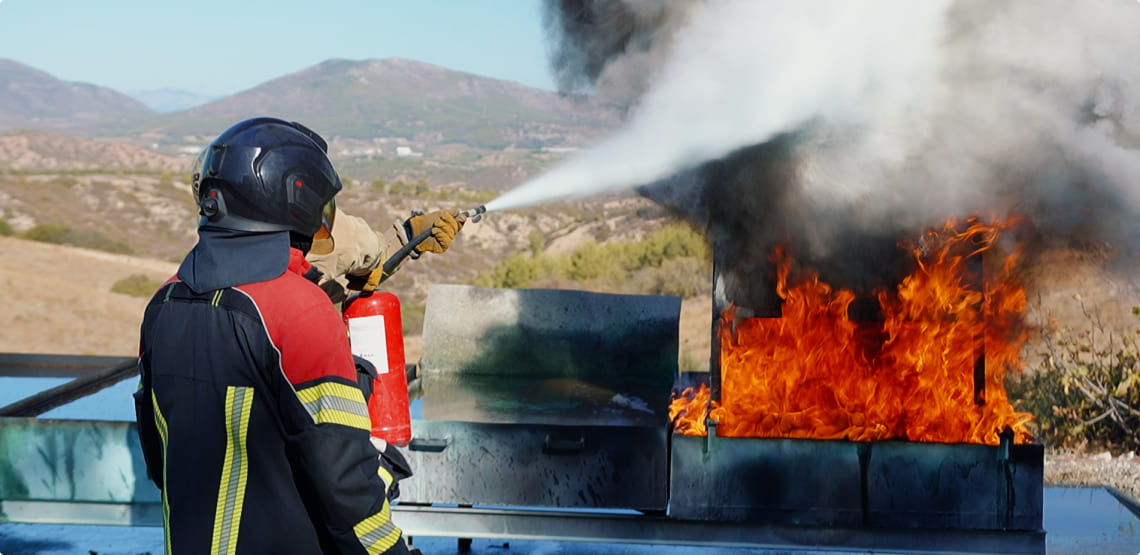
Course
Practice
The practical part is realized at a specialized training field where trainees receive realistic training in the use of all kind of firefighting equipment. The training includes various scenarios and the trainees must firefight using the appropriate equipment and methods.
The trainees learn how to use the fire blanket in real liquid gas fire
The trainees are extinguishing liquid gas fire using the following means and equipment:
- Portable fire extinguishers (dry powder, C02 and foam).
- High-pressure water installation with extinguishing nozzle to manage and achieve special water shots.
- High-pressure water foam installation using foam making apparatus and special foam nozzle.
Every firefighting practice and exercise is guided and supervised by our highly experienced trainers.
The trainees are practicing in tactics and methods of firefighting solid fuel in closed spaces. They are taught how to:
- protect
- use water
- protect themselves using the water hose (various techniques)
- approach
- safely enter closed spaces and manage to put out the fire
Special attention is paid to the design, execution and practice of fire – search – rescue crew training. In our specially designed and constructed containers we implement different scenarios and search and rescue trainings. Our main goal is for the trainees to:
- Get familiar with the personal protective equipment and the breathing device.
- Learn the procedures and techniques of entering closed spaces and follow the safety rules while searching the area.
- Be able to locate and rescue the trapped person within the closed compartment (for the rescue practice a human dummy is used).
- Learn how communicate effectively and appropriately and to practice in Port State Command and Control exercises.

